Which DOS era computer makes for the best retrogaming PC?
Which DOS era computer makes for the best retrogaming PC?
I guess I should add some criteria here. Retrogaming in this context really refers to DOS based gaming. I'm also talking about real DOS era computers or at least something running DOS natively and not via emulation (e.g. DOS Box). Also, this only refers to IBM PC compatibles and clones, not other computers like the Commodore 64, Amiga, Atari 8-bit, Apple II, Apple IIgs. TRS-80, Atari ST, etc. That's a whole other discussion.
I've split the choices mostly amongst socket/slot type as that tends to make for a pretty good division point. The choices are:
XT/AT (basically anything pre-386)
386
Socket 1-3 (486 based PCs)
Socket 5 (early Pentiums, early K6-2s)
Socket 7 (later Pentiums usually with MMX, some K6-2s and K6-3s, some Cyrix)
Super Socket 7 (later Pentiums, K6-2/3/+, Cyrix)
Slot 1 (Pentium II, early Katmai Pentium IIIs and Celerons)
Slot A (classic Athlons)
Socket 370 (later Coppermine and Tualatin based Pentium IIIs and Celerons)
Something newer
The consensus on the net (as much as there could be said to be one) seems to point to Super Socket 7 as being the best choice. Personally, I disagree but I'll get to that below as I summarize each option.
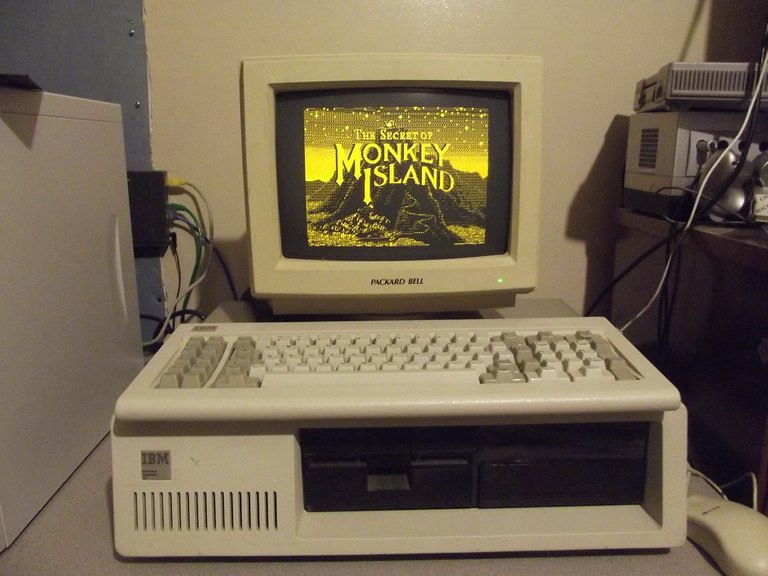
IBM PC XT
XT and AT era PCs can most easily run the earliest games. Running these games on later PCs often requires doing something extra to slow things down. However, XT/AT era PCs can't run a great many later DOS games and early DOS games did not compare well to gaming on other computers at the time like the Commodore 64.
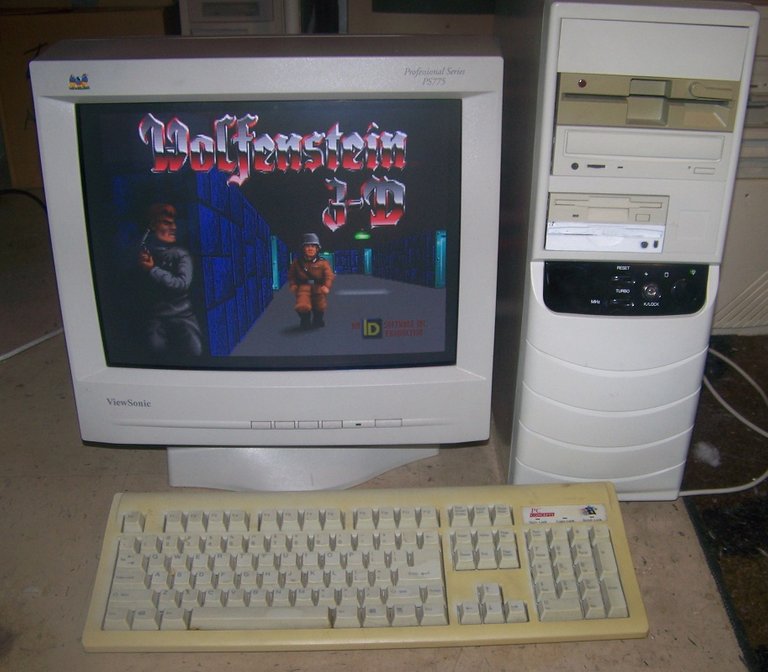
Typical 386 with Wolfenstein 3-D
The era of the 386 is really when PC gaming came into its own. A reasonably fast 386 with VGA graphics can run a vast swath of the available DOS games. Many games required no more than a 386 even into the Pentium era. You could run Doom on a 386 (though not necessarily the best experience). Which is the problem. Anything that you can run on a 386 you can run better on a 486. There was still a large era of DOS games that the 386 can't run (or run acceptably).
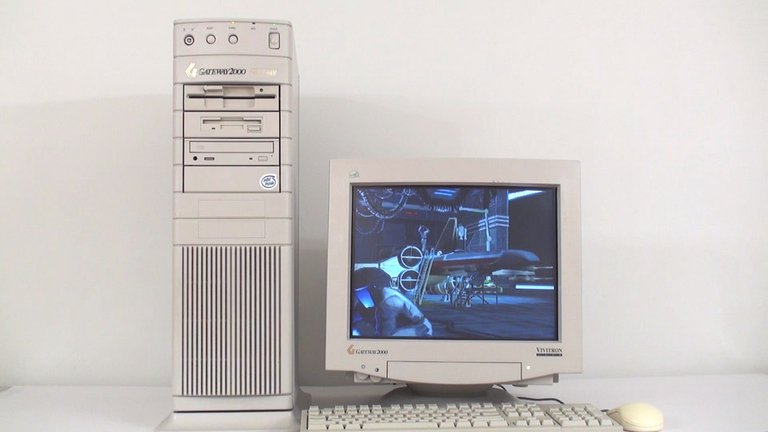
486 from Gateway 2000
The era of the 486 (Socket 1-3) is when Doom was released. In a sense this was the beginning of a new era of DOS gaming. Other computer gaming platforms like the Atari ST and Amiga died out in this era (at least in a commercial sense). My first PC compatible was a 486. Companies like AMD ramped up the speed of the 486 late in its life to remain competitive with early Pentiums. But again, the 486 still isn't fast enough to play all of the best DOS games. Most of them perhaps, but definitely not all.
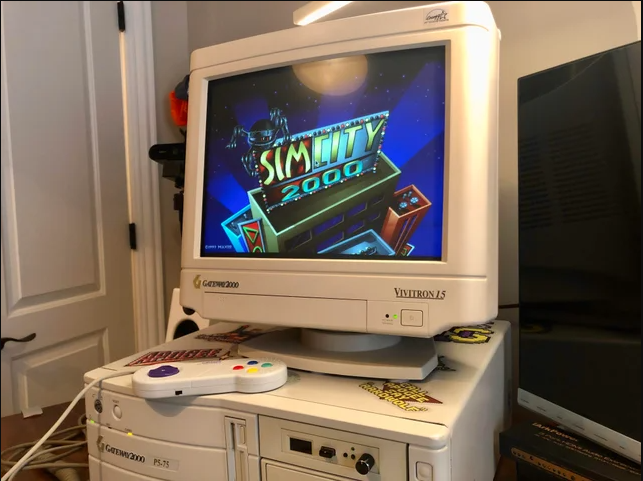
Pentium from Gateway 2000
While the 486 era may have marked a new era of PC gaming, it was the Pentium (Socket 5) that really correlated with the beginning of the Internet age and started to bring computers into many more households. A Pentium was the ideal machine for Microsoft's Windows 95 (still DOS based) operating system (though it worked well enough on my 486). And while Doom may have popularized the FPS genre primarily on the 486 and even 386, it was the Pentium that was needed to acceptably run all the FPS games that followed over the next several years.
Socket 7 made things a little confusing, at least just to go by the socket. Socket 7 allowed for but didn't require split voltage. Without split voltage, the only thing Socket 7 added was slightly higher clock speeds via a higher multiplier (Socket 5 could go to 133 MHz, Socket 7 could go, to 166 or 200). With the split voltage however, you could move up to MMX based processors (as fast as 233MHz) from Intel, or you had some additional AMD K6-2 and K6-3 options that were better values though by the time Quake came around these were not the best choice.
Super Socket 7 was perhaps the platform with the widest possible number of processor choices. Want to run an early Pentium? No problem. Pentium MMX. Easy peasy. Cyrix 686 or MX? Yep, it can do that too. K6-2 or K6-3? Probably the best choices. K6-2+ and K6-3+? While made for mobile, many Super Socket 7 boards supported these as well. The biggest enhancement over standard Socket 7 was support for a 100MHz bus (Socket 7 was limited to 66 MHz).
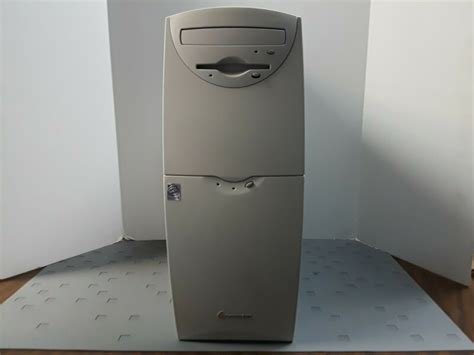
Gateway Pentium II G6-333 (Slot 1)
The Slot 1 era was perhaps among the most interesting. It overlapped substantially with both the Super Socket 7 and Slot A eras. At no time were there more choices. Intel was the safe bet with the Pentium II via Slot 1. However, there were better values for your dollar to be had. Early Pentium IIIs were essentially Pentium IIs with SSE but they were built on an improved process that allowed them to clock higher. Perhaps these would have been more accurately called Pentium II+. The nice thing about early Slot 1 machines is that they could be upgraded with newer, much faster socket 370 celerons with a simple adapter.
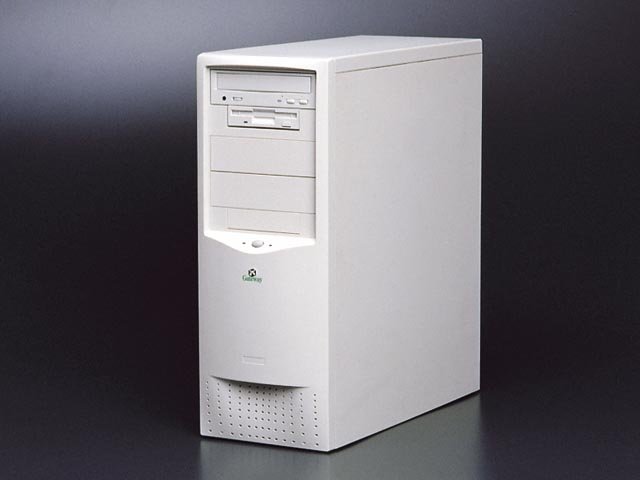
Gateway Select 750 (Athlon Slot A)
Slot A was AMDs answer to Slot 1 and hosted the successor to the K6-2/3 line, the Athlon. Just like the Pentium II/early Pentium III, the Slot A interface was designed so that L2 cache could be added close to the processor that was significantly faster than the motherboard cache popular before that time. Clock for clock, the Athlon was faster than the early Pentium IIIs. The only downside was that they did not have SSE which was not a big deal at the time. These would be the chips that took AMD to 1 GHz and beyond.
Socket 370 was the host to later Coppermine based Pentium IIIs. The biggest difference between these and the Slot 1 variety was that they moved from off-chip based half speed L2 cache to on chip full processor speed cache. Even though in most cases it was half the amount of cache (256K vs. 512K) of the earlier Pentium IIIs, the faster speed more than made up for that difference. These would be the chips that took Intel to 1 GHz and beyond. Intel had caught up to AMD once again.
One choice I left out was Socket 462/Socket A. This one sort of straddles the line between "retro" and "modern" in terms of gaming. Early on this socket was used for faster Athlons (Thunderbird) which like the later Pentium IIIs, moved L2 cache onto the CPU. These would have been included in systems that came with Windows 98. However, Socket A was also used for the later Athlon XP which would have been in XP era computers.
In addition to all of the above options, you can of course use newer platforms. DOS will run on even the newest Intel or AMD processors. However, getting DOS based sound, video, network, and game controller drivers for a modern platform is an entirely different story. It CAN be done on some systems later than the P3 and Athlon though mostly by finding the rare newer hardware that still had DOS drivers or worked with drivers from older devices or by mixing in older video cards/sound cards with newer motherboard/CPU combos.
So of all those options, which is the best? As I said above, Super Socket 7 seems to be a fan favorite and it certainly offers the most variety. However, my choice would probably fall between a Slot A and Socket 370. Why? These were the fastest machines available that came with a DOS based operating system. Windows XP was introduced early in the Pentium 4 era and after that, DOS drivers for new hardware became scarce. So in theory, you should be able to pick up a 1GHz (or slightly faster even) Pentium III or Athlon and with a video card and sound card of the same era be able to play just about any DOS game ever made. You might be able to do the same with some early Pentium 4s but those weren't much faster than Pentium IIIs anyway. Of the two, I would probably pick the Pentium III because by the time clock speeds reached 1GHz I believe the Pentium III was a little faster and it also supported SSE which was a nice bonus even if little used at the time. So at the end of the day, why go with a Super Socket 7 (which could be notoriously finicky anyway depending on your combination of hardware) for which the fastest processor ran at about 550MHz when you could have a 1GHz+ Athlon or Pentium III? No reason at all that I can think of. For sheer nostalgia and variety of configurations to play with Super 7 based PCs might win out but in terms of best bang for your buck retrogaming DOS machine? I don't see how it comes close to a Socket 370 or Slot A based computer. But by all means, tell me what your choice would be by voting in the poll above and/or commenting below.
- XT/AT (basically anything pre-386)
- 386
- Socket 1-3 (486 based PCs)
- Socket 5 (early Pentiums, early K6-2s)
- Socket 7 (later Pentiums usually with MMX, some K6-2s and K6-3s, some Cyrix)
- Super Socket 7 (later Pentiums, K6-2/3/+, Cyrix)
- Slot 1 (Pentium II, early Katmai Pentium IIIs and Celerons)
- Slot A (classic Athlons)
- Socket 370 (later Coppermine and Tualatin based Pentium IIIs and Celerons)
- Something newer
Answer the question at dpoll.xyz.
~~~ embed:1570604146520387585 twitter metadata:Q3JhenlQaGFudG9tQlJ8fGh0dHBzOi8vdHdpdHRlci5jb20vQ3JhenlQaGFudG9tQlIvc3RhdHVzLzE1NzA2MDQxNDY1MjAzODc1ODV8 ~~~
The rewards earned on this comment will go directly to the people( @darth-azrael, @crazyphantombr ) sharing the post on Twitter as long as they are registered with @poshtoken. Sign up at https://hiveposh.com.
Voted for
Voted for
For me it's hard to choose because I had several models mentioned above and each one of them marked an era of my life.
I started with an IBM PC 286 where I learned to use DOS and where I started to play some games that I still enjoy today like PreHistorik/2, Keen, Lemmings, Pacman, Bumpy and much more...
Later I had my first Windows 95 computer which was a Pentium 166Mhz MMX with 16MB RAM where I played among other games, Age of Empires, Theme Hospital, KKND, Seven Kingdoms (yes I am a strategy game lover), etc.
Later I had an ADM K6-3 400Mhz with 4MB cache L2 which was a beast at the time! It was there that I also had my first 3D VooDoo 2 Video card that allowed me to start playing heavier games like Carmageddon.
So my choice goes to Socket 7 (later Pentiums usually with MMX, add K6-2s and K6-3s, add Cyrix).
Each one of them allowed me to live each era and they were just fantastic.
I started with a Commodore 64. I had experience with IBM PC XTs early in high school and later PS2s but I liked my Commodore 64 so much better than those. My first "PC" was a 486 from Gateway. Doom, Doom 2, Mechwarrior 2, NASCAR, X-Wing, Tie Fighter, Heretic, Descent...those are the games I remember the most from that time.
I wanted to upgrade around the Pentium MMX era but was a poor college student at the time. I managed to upgrade a little later with an early Pentium II. X-Wing vs. Tie Fighter, X-Wing Alliance (I really liked this series of games), Baldur's Gate...those are the games I remember most from my P2 days. I probably would have gone with AMD had I been building my own systems at the time. I would with my next PC which was Duron based which would fairly quickly be upgraded to an Athlon XP.
Voted for
I sold Gateway computers from 1998 - 2004, during some of the prime retro gaming times. I remember explaining why you want that extra 4MB ram and that big 200 MB hard drive. Gigabytes were still science fiction back then!
Gateways are definitely my favorite "vintage" PCs. My first PC was a Gateway 2000 4DX2-66V that I ordered some time in July 1993. It came with a 486 DX2-66 processor, 16MB of RAM, a 340MB hard drive and a single speed CD-ROM drive with manually operated tray. I added a Soundblaster 16 ASP and 14.4 modem (both ordered from Gateway who seemed to have great prices for add-ons at the time) by Christmas. Within a year I had a ZIP Drive and a 1 GB hard drive (had to order a BIOS upgrade on floppy to support that). I absolutely loved that machine.
In Christmas 1997 I upgraded to a G6-333 Pentium II (mini tower version) which was also an awesome machine.
By the time I was ready to upgrade again I was building my own computers. The Athlon and Pentium III era Gateways were really the last ones I liked. Recently I picked up a full tower Pentium 133 Gateway 2000. That has got to be the most awesome tower computer ever built. And it is huge.
I'm drooling over all this geekspeak, doesn't seem that long ago when "Pentium" was high-end. I had a zip drive also, I still remember the noise it made. I didn't build my first until much later, I was overclocking a Celeron and installing some of the first video graphic cards.
I'm glad you like the old Gateways, it was sad seeing that company go the way of the dodo. I still have my "Gateway Country" denim shirt with GATEWAY 2000 branded on it. The squishy cows given away with the old PC's have become collectors items - I could have made a fortune if I kept a box or two intact!
Gateways, especially in the 486 and Pentium days, were awesome. I just paid too much (though still far, far less than it originally cost) for a Pentium 133 full size tower that is something I would have upgraded to at the time if I could have afforded it. That gargantuan tower has got to be my favorite design ever and this one was in mint condition...and miraculously survived shipping. Basically the same design as the 486 tower shown in this post.
Pentiums don't seem that old, and honestly they were still usable (albeit not necessarily a pleasant experience) until they finally pulled the plug on Windows XP...at least if you had a higher end one and could cram enough RAM into it. I recently came across a Compaq Presario that had a K6-200MMX in it. Problem is that it had 16MB soldered on and one memory slot and could have a max of only 48MB of RAM. That thing was practically obsolete when it came out because of that limitation.
I got a zip drive for my 486 not too long after they came out. I splurged for the SCSI version. At the time, ~$20 a disk for 100MB was a great deal. I still have it and a few years ago I pulled it out and hooked it up to copy all the old data I had on ZIP disks. It still worked then anyway.
Tbh, it's really hard to choose, a lot of games tie game speed to CPU clock speed, so the PC would be highly unqualified to play certain games either way. I guess a 486 would be your best bet.
Before the 486, a lot of games did go faster as the CPU speed increased. I remember the original MechWarrior was very fast on a 486. I think most games that came out in the 486 era or later didn't have that problem. Usually you could overcome the issue by turning off Turbo and/or using a utility.
I would agree early pentiums would be best.
but boy those early 486's such memories. I loved the original mechwarrior on an old 486 with 4mb of memory.
You could also run vr on them back in the day.
I played the original Mechwarrior some but I played Mechwarrior 2 a lot more. I also played another mech game around the same time as MW2. Earthsiege maybe?
I think it was Earthsiege. I don't know off the top of my head any other ones from that era.
!LUV
@simplegame(4/5) gave you LUV. tools | wallet | discord | community | <>< daily
tools | wallet | discord | community | <>< daily
HiveBuzz.me NFT for Peace
Voted for
Voted for
Voted for
I'm not experienced nor educated regarding most of the things you mentioned here.
!PIZZA
!CTP
My first PC was one returned to store (I worked in a Dixons).
Socket 7
Paid to put extra ram in, it had a ginormous 1.2gb hard drive. I overclocked it to 166 from memory.
Many happy hours playing Total Annihilation, AoE2, & an FPS I cant remember the name of, but was against robots in mines
Voted for
Voted for
Congratulations @darth-azrael! You have completed the following achievement on the Hive blockchain and have been rewarded with new badge(s):
Your next target is to reach 3100 posts.
You can view your badges on your board and compare yourself to others in the Ranking
If you no longer want to receive notifications, reply to this comment with the word
STOPTo support your work, I also upvoted your post!
Check out the last post from @hivebuzz:
PIZZA Holders sent $PIZZA tips in this post's comments:
@vimukthi(5/5) tipped @darth-azrael (x1)
Please vote for pizza.witness!
Voted for
Man monkey island is a classic! Lol miss playing that game
!1UP
You have received a 1UP from @gwajnberg!
@stem-curator, @pimp-curator, @vyb-curator, @pob-curator, @neoxag-curator
And they will bring !PIZZA 🍕.
Learn more about our delegation service to earn daily rewards. Join the Cartel on Discord.
Voted for